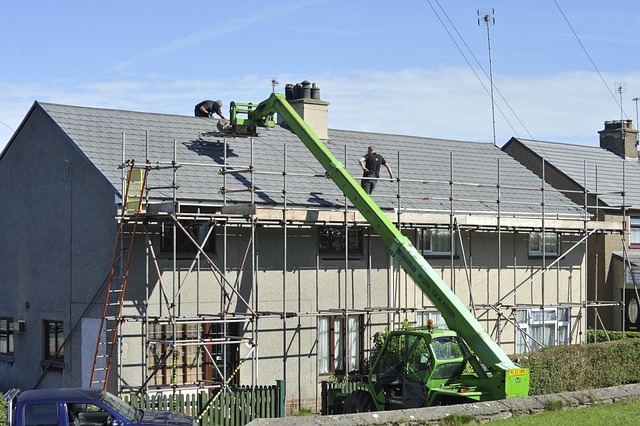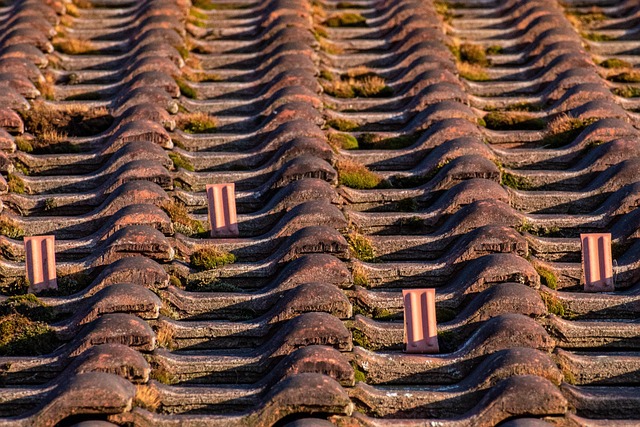Low slope roofing is a preferred choice for warehouses and industrial buildings due to its cost-effectiveness, durability, and practical benefits. Featuring gentle slopes (2-6 degrees), it simplifies installation and maintenance while offering improved weather resistance and energy efficiency. Key materials include bitumen-based membranes, metal panels, and polyurethane foams. Effective drainage systems are crucial for preventing water damage. The installation process involves careful preparation, waterproof membranes, and precise fastening techniques. Low slope roofing reduces material and labor costs compared to traditional sloped roofs, enhances insulation, and ensures structural integrity with proper maintenance, including regular inspections, cleaning, and protective coatings.
Low slope roofing, a prevalent system in warehouses and large commercial buildings, offers a practical and efficient solution for space optimization. This article delves into the intricacies of this roofing type, exploring its applications, materials, installation, and benefits. We’ll uncover why low slope roofs are gaining popularity and how their design provides advantages in terms of aesthetics, energy efficiency, and structural integrity. Additionally, we’ll discuss maintenance practices to ensure longevity.
- Understanding Low Slope Roofing: An Overview
- Common Applications in Warehouses and Commercial Spaces
- Materials Used for Low Pitch Roofs
- Installation Processes and Techniques
- Advantages and Benefits of Shallow-Pitched Roof Systems
- Maintenance and Longevity Considerations
Understanding Low Slope Roofing: An Overview

Low slope roofing is a prevalent architectural choice for warehouses, large commercial buildings, and other industrial spaces due to its numerous advantages. Unlike traditional sloped roofs with steep inclines, low pitch roofs feature gentle slopes, typically between 2-6 degrees. This design not only offers a visually appealing aesthetic but also provides practical benefits tailored to the demands of modern commercial structures.
The simplicity of low slope roofing systems makes them cost-effective and efficient to install and maintain. These systems often consist of a waterproof membrane, underlayment, and a suitable drainages system designed specifically for low slope applications. Effective roof drainage systems are crucial to prevent water accumulation and potential damage, ensuring the longevity of the roof. This type of roofing is also known for its durability, resilience to extreme weather conditions, and reduced heat absorption, contributing to better energy efficiency in large commercial spaces.
Common Applications in Warehouses and Commercial Spaces

Low slope roofing is a popular choice for warehouses and large commercial spaces due to its functional benefits and cost-effectiveness. This type of roofing system offers a seamless, flat surface ideal for heavy equipment operations and easy maintenance. In warehouses, where space optimization is key, low slope roofs allow for better interior volume utilization without the need for additional structural support compared to steeper sloped roof designs.
Furthermore, these systems incorporate efficient roof drainage solutions, ensuring water is swiftly removed from the surface, a critical aspect in preventing damage and prolonging the roofing material’s lifespan. This application of low pitch roofs is particularly advantageous in regions with substantial snowfall or heavy rainfall, where proper drainage can mitigate structural strain and reduce maintenance requirements over time.
Materials Used for Low Pitch Roofs

Low slope roofing, or what is more commonly known as a low pitch roof, presents unique challenges and opportunities when it comes to materials selection. This type of roofing system, often found in warehouses and large commercial spaces, requires specific materials that can withstand prolonged exposure to weather conditions while maintaining a flat or slightly inclined surface.
The primary materials used for low slope roofs include bitumen-based membranes, metal panels, and polyurethane foams. Bitumen membranes, such as EPDM (Ethylene Propylene Diene Monomer) and TPO (Thermoplastic Olefin), are popular choices due to their durability, flexibility, and excellent resistance to ultraviolet radiation. Metal panels, including aluminum and stainless steel, offer superior strength and corrosion resistance, making them ideal for environments with high humidity or corrosive substances in the air. Polyurethane foams, when combined with a protective topcoat, provide exceptional insulation properties while maintaining a low profile. Additionally, roof drainage systems are crucial components of low pitch roofs to ensure proper water management and prevent damage caused by stagnant water on the surface.
Installation Processes and Techniques

The installation process for low slope roofing systems, often characterized by their shallow pitches, involves a series of precise steps tailored to ensure durability and water-tightness in commercial spaces like warehouses. Professionals begin by preparing the roof deck, ensuring it’s clean, dry, and free from any debris. This critical step forms the base for effective adhesion of the roofing materials. Following this, a layer of waterproof membrane is applied, creating a protective barrier against moisture intrusion.
Techniques vary based on the specific low slope roofing system chosen, but common methods include mechanical fastening or adhesive bonding. Mechanical fasteners like screws or staples secure the membranes in place, while adhesives offer a seamless bond between the roof deck and the membrane. For added reinforcement, a layer of reinforcement mats may be incorporated, enhancing the structural integrity of the roof. Lastly, the installation concludes with the application of roof drainage systems to efficiently manage water runoff, preventing any potential damage caused by excessive water accumulation.
Advantages and Benefits of Shallow-Pitched Roof Systems

Shallow-pitched roofing systems, often referred to as low slope roofing, offer several advantages for warehouses and large commercial spaces. One of their key benefits is cost-effectiveness; these systems typically require fewer materials and labor compared to sloped roof designs, making them a budget-friendly option for businesses. Additionally, low pitch roofs are easy to maintain and clean, reducing the need for frequent repairs and saving time and resources in the long run.
Another advantage is improved energy efficiency. The flat surface allows for better insulation, which can significantly reduce heating and cooling costs. Moreover, these systems enable efficient roof drainage systems, crucial for preventing water damage. By managing rainwater effectively, they contribute to the overall structural integrity of the building, ensuring longevity and minimizing potential repairs related to moisture intrusion.
Maintenance and Longevity Considerations

Low slope roofing systems, while popular for warehouses and large commercial spaces due to their sleek, flat appearance, require specific maintenance considerations to ensure longevity. Regular inspections are crucial to identify any signs of damage or leaks early on. These can include checking for missing or damaged shingles, flashing, or sealants, as well as assessing the condition of the roof drainage systems, which are vital in managing water flow and preventing overflow.
Proper maintenance also involves timely cleaning to prevent debris buildup, which can obstruct roof drainage systems. Additionally, regular re-application of coatings or membranes helps protect the roofing material from ultraviolet radiation and extreme weather conditions, thereby extending the life of the low pitch roof. In terms of sloped roof design alternatives, proper upkeep is even more critical to maintain the structural integrity and aesthetic appeal of these relatively flat structures.
